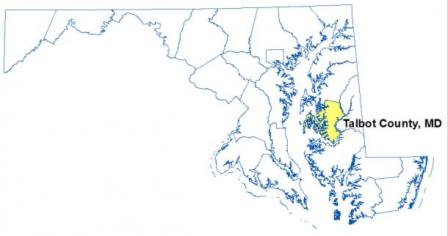Stories of Progress in Achieving Healthy Waters
U.S. EPA Region 3 Water Protection Division
Talbot County, Maryland • February 4, 2016
EPA-supported solar panels and wind turbines have helped a Talbot County, Maryland, biosolids treatment plant turn a tidy profit and cut greenhouse gases.
In 2014 alone, the power generated by the renewable energy sources at the plant produced an economic benefit of nearly $120,000 and prevented more than 450 metric tons of carbon from entering the atmosphere.
The “Renewable Energy Demonstration Project Exit” includes 300 kilowatts (kW) of solar arrays and three 100 kW wind turbines. Together they generate about 600,000 kW hours per year, twice the original projection and more than enough to power the biosolids facility – a plant that receives, treats and disposes of septage from thousands of septic tanks in Talbot and adjacent Caroline counties on the Eastern Shore.
The excess power is sold directly to Old Dominion Electric Cooperative and sold as Renewable Energy Credits (RECs) to Easton Utilities. The county in 2014 generated $23,780 from the sale of excess electricity and nearly $93,500 in RECs, according to Talbot County Engineer Ray Clarke – taking in 20 times more than it had once paid in electric costs to operate the biosolids facility.
Clarke said that solar has been outperforming wind in power generation by a 2-1 margin, due in part to the turbines’ relatively inland location and some temporary issues with communications infrastructure.
Coordinating with the EPA Mid-Atlantic Water Protection Division’s Office of Infrastructure and Assistance and the State of Maryland, Talbot County received $3.8 million through the EPA Clean Water State Revolving Fund for the design and construction of the renewable energy projects.
The projects at the biosolids plant helped spark a clean energy movement in the county. Clarke said that 60 percent of the energy consumed by Talbot County comes from renewable sources.
That commitment has made the county eligible for benefits under the Maryland Energy Administration’s Smart Energy Communities Exit program, including funds this summer to add to the county’s clean fleet with vehicles that run on propane. The county has already purchased plug-in hybrid vehicles with sun-tracking solar arrays and installed solar panels for its community center.
“We’ve positioned the county extremely well with all of these initiatives,” said Clarke. “And we’re now looking hard at solar at our wastewater treatment plants.”

-
Sun, Wind Help Maryland Plant Spin Profit, Cut Pollution (PDF)(1 pg, 693 K,
02/04/2016)
EPA-supported solar panels and wind turbines have helped a Talbot County, Maryland, biosolids treatment plant turn a tidy profit and cut greenhouse gases.
